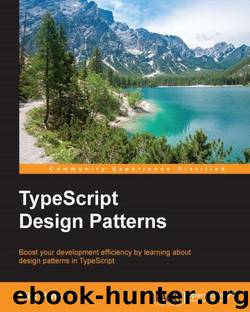TypeScript Design Patterns by 2016

Author:2016
Language: eng
Format: mobi, epub
Publisher: Packt Publishing
Façade Pattern
The Façade Pattern organizes subsystems and provides a unified higher-level interface. An example that might be familiar to you is a modular system. In JavaScript (and of course TypeScript), people use modules to organize code. A modular system makes projects easier to maintain, as a clean project structure can help reveal the interconnections among different parts of the project.
It is common that one project gets referenced by others, but obviously the project that references other projects doesn't and shouldn't care much about the inner structures of its dependencies. Thus a façade can be introduced for a dependency project to provide a higher-level API and expose what really matters to its dependents.
Take a robot as an example. People who build a robot and its components will need to control every part separately and let them cooperate at the same time. However, people who want to use this robot would only need to send simple commands like "walk" and "jump".
For the most flexible usage, the robot "SDK" can provide classes like MotionController, FeedbackController, Thigh, Shank, Foot and so on. Possibly like the following image shows:
Download
This site does not store any files on its server. We only index and link to content provided by other sites. Please contact the content providers to delete copyright contents if any and email us, we'll remove relevant links or contents immediately.
The Mikado Method by Ola Ellnestam Daniel Brolund(20667)
Hello! Python by Anthony Briggs(19959)
Secrets of the JavaScript Ninja by John Resig Bear Bibeault(18273)
The Well-Grounded Java Developer by Benjamin J. Evans Martijn Verburg(17636)
OCA Java SE 8 Programmer I Certification Guide by Mala Gupta(17466)
Kotlin in Action by Dmitry Jemerov(17250)
Algorithms of the Intelligent Web by Haralambos Marmanis;Dmitry Babenko(16280)
Grails in Action by Glen Smith Peter Ledbrook(15434)
Sass and Compass in Action by Wynn Netherland Nathan Weizenbaum Chris Eppstein Brandon Mathis(13293)
Test-Driven iOS Development with Swift 4 by Dominik Hauser(10406)
Windows APT Warfare by Sheng-Hao Ma(7833)
Layered Design for Ruby on Rails Applications by Vladimir Dementyev(7549)
Blueprints Visual Scripting for Unreal Engine 5 - Third Edition by Marcos Romero & Brenden Sewell(7450)
Solidity Programming Essentials by Ritesh Modi(4568)
Functional Programming in JavaScript by Mantyla Dan(4441)
Hands-On Full-Stack Web Development with GraphQL and React by Sebastian Grebe(4431)
WordPress Plugin Development Cookbook by Yannick Lefebvre(4386)
Unity 3D Game Development by Anthony Davis & Travis Baptiste & Russell Craig & Ryan Stunkel(4270)
The Ultimate iOS Interview Playbook by Avi Tsadok(4252)
